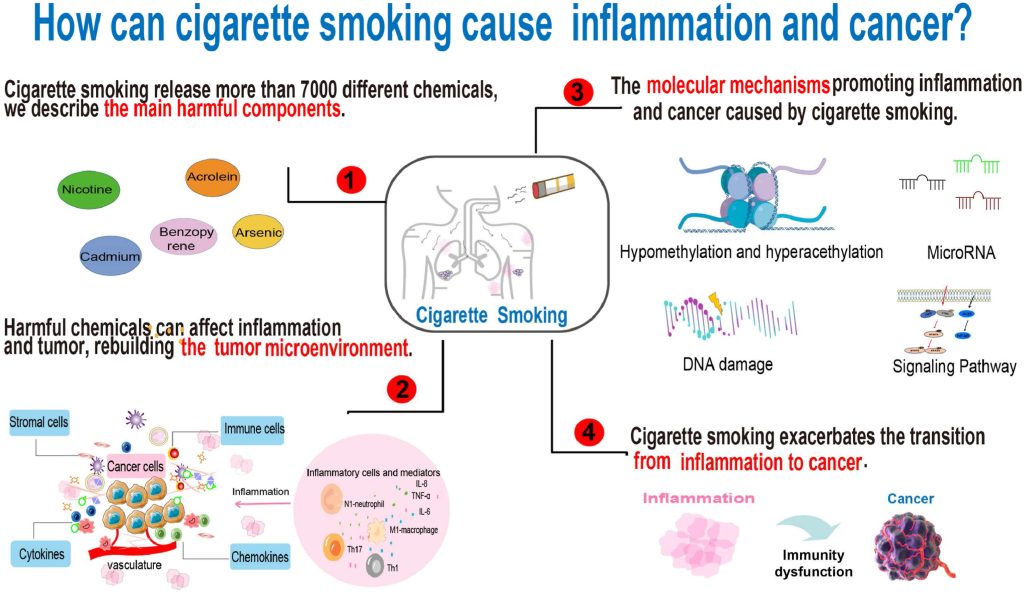Cigarette smoking is a leading cause of preventable diseases worldwide, and its detrimental effects on health extend far beyond respiratory issues. The association between smoking and inflammation leading to cancer is a complex interplay of various chemicals and molecular mechanisms. According to Liu et al. 2023, four processes through which smoking induces inflammation and increases the risk of cancer can be derived as shown in Figure 1.

Release of Harmful Chemicals
Cigarette smoke comprises over 7000 different chemicals, each with its own set of effects on the human body. Among these, nicotine, acrolein, benzopyrene, cadmium, and others emerge as the most harmful. These substances are not only directly toxic but also play a crucial role in initiating the processes that lead to inflammation and cancer.
Interaction with Immune Cells
Nicotine, a highly addictive component of tobacco, interacts with immune cells, triggering a cascade of events that contribute to inflammation. The immune system, designed to protect the body, can be compromised by the continuous exposure to these harmful chemicals. This interaction disrupts the balance of immune responses, creating an environment conducive to inflammation and, ultimately, cancer.
Modulation of Inflammatory Mediators
Acrolein, benzopyrene, and other components of cigarette smoke modulate inflammatory mediators within the body. These mediators, such as cytokines and chemokines, play a crucial role in the inflammatory response. The dysregulation induced by smoking can lead to chronic inflammation, a known precursor to various types of cancer. Understanding how these mediators are influenced by smoking is key to unraveling the intricate web of smoking-induced inflammation.
Remodeling the Tumor Microenvironment
Cadmium, found in cigarette smoke, has been implicated in remodeling the tumor microenvironment. This process involves altering the surrounding tissue and cellular structures to create a favorable environment for the growth and spread of cancer cells. The tumor microenvironment is a complex network of cells, blood vessels, and signaling molecules, and smoking-induced changes can tip the balance towards a pro-cancer state.
Molecular Mechanisms Involved
The molecular mechanisms underlying smoking-induced inflammation and cancer are multifaceted. The following key processes shed light on the intricate ways in which smoking contributes to the development of cancer:
Induction of DNA Damage
Cigarette smoke contains numerous carcinogens capable of directly damaging DNA. This damage can lead to mutations, which, if left unrepaired, may result in uncontrolled cell growth and cancer. The continuous assault on the genetic material of cells is a fundamental mechanism through which smoking contributes to the initiation and progression of cancer.
Epigenetic or Chromatin Modification
Epigenetic modifications involve changes to the structure of DNA that do not alter its sequence but can influence gene expression. Smoking has been linked to epigenetic changes, such as DNA methylation and histone modification. These alterations can affect the regulation of genes involved in cell growth, differentiation, and apoptosis, all of which are crucial in the context of cancer development.
Activation of Oncogenic Signaling Pathways
Smoking activates various signaling pathways within cells, including those classified as oncogenic or cancer-promoting. These pathways regulate cell survival, proliferation, and differentiation. Dysregulation of these pathways due to smoking can lead to the uncontrolled growth of cells and the evasion of normal regulatory mechanisms, contributing to the development of cancer.
Conclusion
In summary, the link between smoking, inflammation, and cancer is a complex interplay of various chemicals and molecular mechanisms. Understanding the processes involved in the initiation and progression of smoking-related cancers is crucial for developing effective prevention and intervention strategies. Smoking cessation remains the most effective way to reduce the risk of cancer and other smoking-related diseases. Public awareness, education, and ongoing research efforts are essential to combat the global health burden associated with cigarette smoking.
Other interesting articles:
Social Media Exposure Linked to Increased Tobacco Use Among Youth
WHO: There is no safe level of alcohol consumption for our health
Reference

